Advertisement
Elusive. Sly. Secretive. And always on red alert. Big white-tailed bucks grow big for a reason—they’re far from clueless. By the time they reach age three, in fact, they’ve been exposed to all manner of threat, making them well-adapted to living in the vicinity of predators, including humans. And with their incredibly acute senses, mature bucks seem almost psychic, disappearing the moment deer season begins. This is especially true in areas with hunter pressure—trophy whitetails will seemingly shut down most daytime activity and go nocturnal. When that happens, you can still get your wall-hanger, but you’ll need to rethink your options. Here are seven key strategies for staying in the game.
Strategy 1: Move in deep
Advertisement
As hunting pressure mounts, field-edge treestands won’t cut it for ambushing prime-aged bucks. Once they’re only passing within range of your stand after dark, it’s time to relocate farther into the forest.
The larger the woodlot, the greater the probability that one or more mature bucks will live there. It’s likely you’ve spotted them while glassing summer fields during dawn or dusk scouting trips, or that your field-edge trail cams have captured photo evidence. But we all know that once deer season arrives, the same bucks that would casually feed in the far corner of the field have now vanished.
The truth is, they’re probably still feeding in the same field—assuming the crop is still there—but only under the protection of darkness. Remember, mature bucks have already survived three or more deer seasons and they’ve likely had a close call or two. They’re educated to the patterns of hunters. Come autumn’s frosts, they become downright reclusive, often slinking back into the farthest, thickest, dirtiest part of their forest home for daytime security. If you want to glimpse them during legal hours, that’s where you have to go, too.
Advertisement
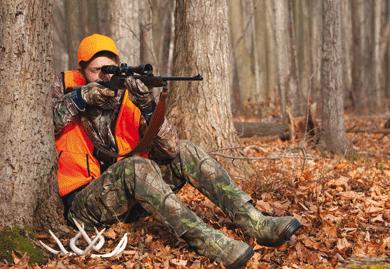
Tactical tips: Hunters who make the effort to set up in the far reaches of the woods are more likely to spot a mature buck, especially on land that draws a number of hunters. The farther back you venture into undisturbed bush, the better the chance big bucks will be hoofing around during daylight hours. The trick is to scout quietly, find an active scrape line, then set up a couple of stands to account for varying wind directions. If there’s the potential for such a remote set-up where you hunt, it deserves the focus of your time afield.
If you don’t know where the bucks are roaming by the time gun season begins, it’s not too late to find out. An ideal strategy is to still-hunt the area during the rut while simultaneously scouting. If you discover active buck sign, settle into a natural ground blind for the remainder of the day. This minimizes disturbances of the immediate area, which is important because the hunt is already on and you don’t want to alert any nearby bucks.
Carry a camouflaged folding chair and park within range of the active sign. No chair? Just sit on the ground, up against a big tree. Some daypacks now come with a built-in pop-out seat cushion, which is perfect for this style of mobile hunt. By hunting this way, nothing is left behind to catch the attention of a wary buck, and you can situate yourself in a different spot each day so the deer won’t be able to pattern your ambush set-up.
Strategy 2: Find the bedrooms
Pressured bucks escape by spending most of their time in secretive bedding areas, especially during the pre- and post-rut. The challenge is to find these trusted hideouts without significantly spooking your future trophy.
Typical bedding haunts are stands of evergreens, 10-plus acres in size that hug the border of a wet area. Fully grown cedar bushes with a dousing of hemlock and pine are prime locales. Bucks have been known to have daybeds on hardwood ridges, but they’re less likely to use them when there’s hunter pressure.
With your scent under control, you can risk one scouting foray through a potential bedding area; if you scare off any inhabitants, it will only be for the short term. Look for telltale buck sign, as well as the previous year’s antler sheds. If you find sheds, you’ll know the big boys used the bedding area through the winter and that it will still hold animals during the post-rut.
Also look for the previous season’s rubs, although the fresher the sign, the better. By mid-October, you’ll want to see proof of an ill-tempered buck, whose skyrocketing testosterone levels are driving him to rub the bark off any tree that gets in his way. Bucks always rub a tree on the side they first approach it from, so this can help you determine the likely direction he’ll be coming from on future visits.
Without hunting pressure, mature bucks will finish feeding and head to their bedding area within an hour or so of sunrise. They’ll remain in this trusted sanctuary until late afternoon, then slowly feed their way back to their preferred food source. If pressured, they’ll go nocturnal, returning to the feeding area only under cover of darkness. However, they’ll remain active farther back in the woods, feeding, drinking and making rubs and scrapes in and around their bedding area during legal hunting hours.
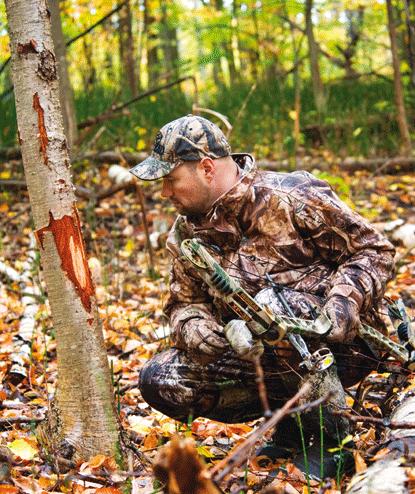
Tactical tips: The winning ticket is to find a fresh rub line and scrapes bordering the bedding area along the transitional zone, where the cedar bush meets the hardwoods. Bruiser bucks will vent their frustration by making signposts as they exit their bedding area each afternoon. Quietly set up a treestand or blind within range, on the downwind side, to hunt this hot sign.
Avoid crossing the buck’s travel route when walking into, or out from, your stand. Plus, your scent should never cross his bedroom exit point. If you hike in or out during darkness, make sure to only shine a small flashlight directly toward the ground in front of you so as not to alert the deer. Treestands or blinds that border a buck’s bedroom are best if hunted all day, given deer will forage briefly and seek out a drink during midday.
Strategy 3: Make deer sounds
Luring bucks by mimicking deer vocalizations, or reproducing the sounds of battle, is an extremely exciting way to notch your tag. Calling and rattling doesn’t work every time, simply because there may not be deer within hearing distance, or the deer might be of the wrong sex to be interested in the sounds you’re making. As well, a big buck may already be tending a doe and unwilling to leave her side. Under the right conditions, however, calling or rattling in an aggressive buck can be a huge adrenaline rush.
Calling sequences should be brief. I’ve had the most success with a couple of doe bleats, followed roughly 10 seconds later with a buck grunt, then a longer, drawn-out tending grunt that begins quietly and increases in volume over several seconds. The goal is to create the illusion of a buck pursuing a doe in heat, which any nearby bucks will find irresistible. Always wait at least 30 minutes before repeating the sequence.
For rattling, I prefer to use an average-sized set of antler sheds. The first rattle should represent a sparring bout, in case there’s a buck closer than anticipated. Keep it short, lasting just 10 to 15 seconds. Pause for 10 seconds and repeat once, then sit tight for 30 minutes. If no buck dares show himself, assume that none were within hearing distance.
If you’re hunting close to, or during, the rut, ramp it up with another sequence, this time sounding like a full-on fight. Bring the sheds together with force, grinding the tines, main beams and bases together on and off for 30 seconds, but not longer. Bucks that respond to this aggressive rattling can appear quickly, ready to kick butt—it’s best not to get caught holding the sheds instead of your bow or gun when that happens.
If you’re rattling from the ground, also snap twigs and kick leaves to make it sound even more like two 200-plus-pound warriors going at it. The more realistic your bout sounds, the better the chances of raising the ire of the local boss buck. After the second, fight-filled rattling sequence, I let the woods remain quiet for an hour or so.
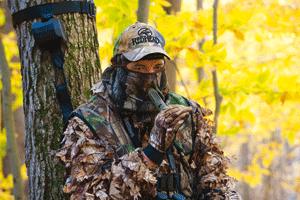
Never make vocalizations at the same time as rattling. About 15 seconds before the heavier, fight-rattling sequence, however, I’ll occasionally make a brief snort-wheeze. This aggressive call mimics a buck’s final warning before raining down his antlers on a rival. All but the most dominant bucks will avoid this intimidating call—it sounds like a buck clenching his teeth and inhaling and exhaling several very quick, short breaths, finishing with one longer inhale. You can easily make this call yourself without a grunt tube.
Tactical tips: When purchasing a grunt tube, also get an instructional DVD with examples of proper deer vocalizations you can mimic. YouTube also has some helpful videos. Some deer calls work better for some people than others—if you have difficulty producing realistic calls from one type of grunt tube, try another.
Don’t rattle aggressively during the first three weeks of October or during the post-rut, since all-out buck battles are extremely rare during these times; such intense sounds will only spook the deer.
Strategy 4: Look for bottlenecks
One of the best ways to position yourself within range of a heavy-beamed rutting buck is to study your hunting territory’s topography. Look for funnels that offer added cover for deer sneaking between bedding and feeding areas, or from one bushlot to another.
Anywhere the terrain narrows because of natural or man-made obstructions makes for a dynamite ambush site. Such pinch points can be created by the likes of a large fallen tree, a river’s edge, a beaver dam, a small cliff or rock ledge in the hardwoods, a stone hedgerow between fields or a drainage that crosses a field.
Tactical tips: Don’t limit yourself to only scouting for existing bottlenecks—also keep an eye out for places where you can slightly alter the terrain to create a more appealing pinch point for the deer.
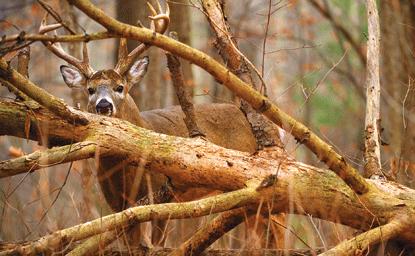
Sparsely treed farm hedgerows that separate agricultural fields can provide concealment for cautious bucks. Typically, these hedgerows have at least one location where the rocks have been cleared to allow the farmer’s tractor to pass. If this break is along a sheltered end of the field, you’ve found a potential funnel, or bottleneck. Check for nearby rubs, scrapes and tracks. With permission, you could make an additional opening in the part of the field with the most deer sign—make sure it’s close to a suitable tree for a stand or has ample nearby brush to hide a ground blind.
Another example would be to simply cut a narrow trail through an otherwise dense thicket. Deer follow the path of least resistance, so such a subtle route would be readily adopted if it makes it easier for them to travel between their bedding and feeding areas.
Likewise, if there’s been a substantial snowfall of more than two feet, you can pack down the snow with your snowmobile or ATV to create a trail the deer will follow. Plan the route with care so that it leads from a secret bedding area to a food source—and right past your stand.
Strategy 5: Hunt watery hideouts
When hunter pressure is at its heaviest, mature bucks will gravitate toward water. Wet areas trump all others when it comes to whitetail security, because water eliminates their scent trail—a necessity when predators such as wolves are in hot pursuit.
Deer also know humans are almost never willing to cross wet areas or wander into swamps, and that’s exactly where big, smart bucks hide when they feel overexposed in their mainland bedding areas—a small rise 40 yards out into the cattails can be enough of a safe haven for the biggest buck.
Tactical tips: Your best bet is to find a small, swampy island a short distance from shore where humans likely haven’t tromped for generations, if ever. It should be just a few acres in size, with some dense thickets. Think ahead and stow a canoe nearby so that when the deer do head for their watery hideouts, you’re at the ready to access the island.
When setting up, hunker down in tall grass up against an evergreen or some cattails. A small ground blind or a folding chair is sufficient. Be careful not to park yourself too close to where the deer enter or exit this hidden sanctuary. To fool ol’ mossy horns, minimal disturbance is essential. And once you’ve discovered one of these moat-protected bedding areas, it could be your secret buck-hunting haven for years to come whenever hunting pressure ramps up.
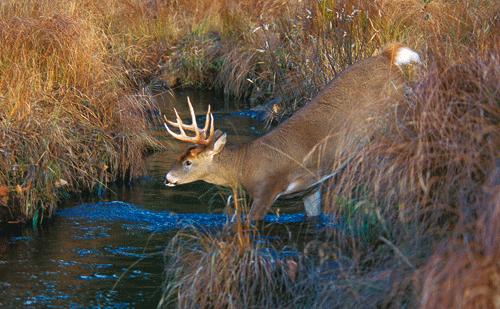
Strategy 6: Use confidence decoys
A decoy can make a deer feel more at ease as it emerges into a field or approaches your stand. Indeed, the sight of a realistic-looking buck or doe decoy can be as effective as hypnosis to a deer with surging hormones. Testosterone-charged bucks are most easily fooled by decoys during the final two weeks of the pre-rut, as well as throughout the rut and for the first two weeks of the post-rut (typically mid-October to the end of November).
Decoys are best placed in a highly visible area. A cruising buck may swing off his intended path, lock onto the decoy and trot in, presenting you with a shot. Visible portions of feeding areas, staging areas, travel corridors and bottlenecks are all great locations to set up decoys.
Keep in mind that bucks will usually circle 20 to 30 yards downwind on approach, so always place the decoys upwind or crosswind from your planned ambush position. And place them so that the buck will have to expose his vitals in order to circle downwind of the set-up. Also make sure to firmly stake down your decoys so the wind doesn’t topple them over once you’re up in your treestand.
If you’re hunting a field edge, another tactic many successful hunters are now employing is to place three or four non-strutting wild turkey decoys in the field. The sight of what appears to be turkeys calmly feeding can instantly convince deer the field is safe. Turkey decoys can be used alone or in combination with a deer deke, but resist placing the two species within 40 yards of one another—they may trust one another’s instincts, but they don’t necessarily enjoy spending time together.
How about setting up two deer decoys? Does this create twice the attraction? I believe it can. During the past couple of seasons, I’ve had great success with a doe deke appearing to be pursued by a buck decoy set up 10 yards behind it.
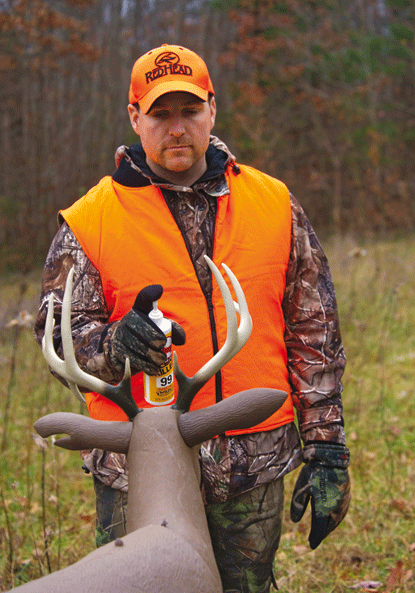
Tactical tips: My favourite dekes feature a head and tail that sway with the slightest breeze, not unlike a bobble-head. This brings some lifelike movement to the otherwise static stance. You also want decoys that are realistic-looking, lightweight, compact and portable. Do you have long hikes into your stand? The farther you have to walk, the more portable and compact the decoys should be.
As with most new products, decoys are rarely scent-free when you purchase them. Apply scent-eliminating spray to their entire surface, then place them outdoors to air out for a few weeks before putting them to use on a hunt. Always wear scent-free gloves when handling your decoys, and make sure to store them in sealed, scent-free containers or bags. As well, never carry them on your ATV or store them in your garage—exhaust does not smell like a doe in heat or a rutting buck.
As for stashing your decoys in the field when you’re not hunting, don’t do it. Any deer living in the area will find them and check them out, all but eliminating the chance they’ll get fooled the next time you set out the decoys.
Some new versions have become so realistic they can even fool other hunters, so deploy them with caution. I never use decoys during gun season in areas with a lot of pressure, for example. For the hike in or out of the bush, always strap a blaze orange vest over the decoy’s head and back, even during bow season. And while setting up, make sure the vest remains visible by draping it over a nearby branch until you’re ready to climb into your stand.
Strategy 7: Avoid other hunters
The ultimate strategy for hunting Booner bucks is to find properties where there is zero hunter pressure. Simply, hunters who find their own secret haunts have the highest probability of shooting breeder bucks.
Even though hunters may share the same goal, they don’t all approach it with the same strategy and attention to detail. Even one hunter can have a hugely negative impact on daytime whitetail movement on a property if he’s careless about scent management or minimizing noise and movement.
The ideal scenario is to have two or three substantial properties—500-plus acres each—where deer have a significant forest for daytime shelter, ample food resources and a water supply. If you don’t already have such a whitetail haven to yourself, do some scouting. And it never hurts to simply ask landowners or farmers if they allow hunting on their property, or if anyone is already hunting it. If they’re uncomfortable with gun hunting, they might be open to having you bowhunt on their land.
Tactical tips: Once you’ve gained permission to hunt a property that hasn’t been pressured by other hunters, it’s time to develop a scouting plan. Google Earth can quickly provide a visual of the land, allowing you to see where the deer might bed down, travel and feed. Follow this up by hiking the property with the aerial printout in hand, making note of any rubs, scrapes, tracks or trails you discover.
To determine the calibre of any bucks in the area, place a couple of trail cameras near active sign, especially scrapes. No-glow infrared cams are best for not disturbing the deer, because there’s no flash when a picture is taken. Some models can even instantaneously transmit photos to your smartphone or home computer. But when it comes to actually putting a trophy buck on the ground, you’re still going to have to do things the old-fashioned way, and that means matching wits with the wariest animal in the fall woods.
